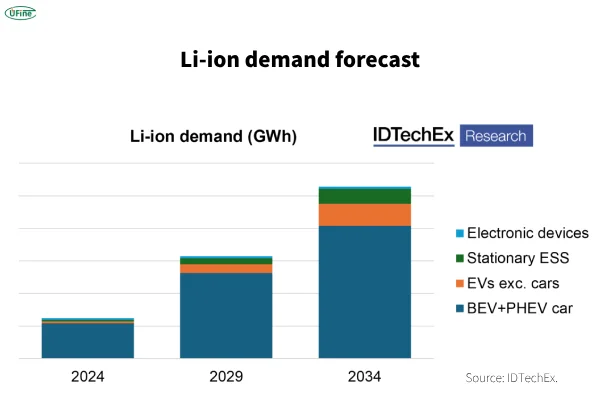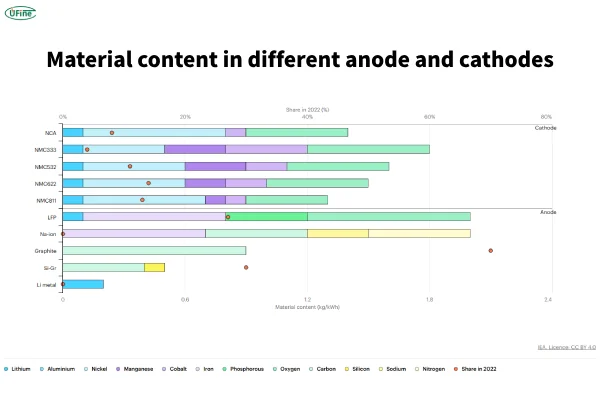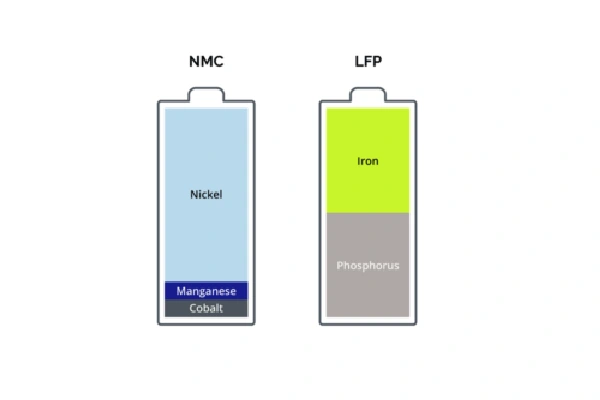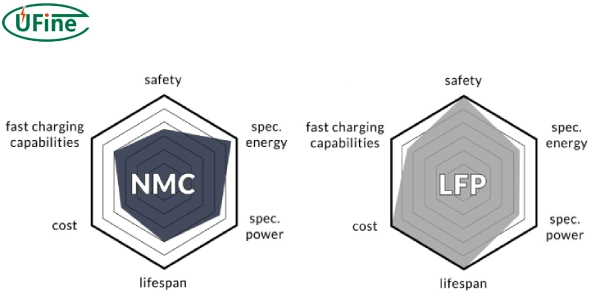The NMC Lithium-ion battery is referred to as a nickel, manganese, or cobalt battery. It is a long-term source of energy. This luminous battery has a high energy density. It is a reliable energy source. Lithium NMC batteries are used in electric vehicles and electronics.
Moreover, it is widely used in energy storage systems and mobile devices. The popularity of these batteries is growing day by day. So, understanding their features and workings is important. The global market for Li-ion battery cells alone is forecast to reach US$380 billion by 2034. This article will shed light on the specifications, pros, and cons of NMC lithium-ion batteries.
Part 1. What is an NMC lithium-ion battery?
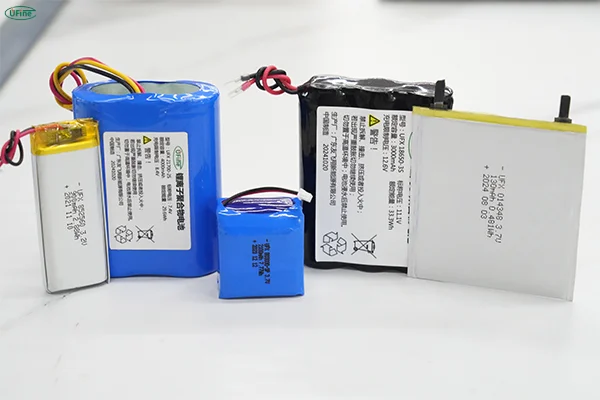
NMC lithium batteries are widely used in the automotive industry. This is because they store large energy in a small mass.
The combination of nickel, cobalt, and manganese is responsible for the high energy storage capacity of lithium NMC.
Nickel provides high specific energy to the battery but is less stable.
Manganese provides thermal stability. So, it lessens overheating during charging and discharging.
Cobalt is used in lithium NMC batteries to reduce cathode corrosion. However, cobalt is expensive and harmful to the environment. So, many manufacturers are trying to reduce cobalt in NMC batteries.
Part 2. The main parts of the NMC battery
It consists of three main parts. These are the cathode, anode, and electrolyte. These parts work together. So, they allow the movement of lithium ions during charging and discharging cycles.
- Cathode: The cathode comprises nickel, manganese, and cobalt. These three materials are used in different concentrations based on the battery design.
- Anode: Like all other lithium batteries, the anode is constructed from graphite. Graphite allows the storage and release of lithium ions while the battery is working.
- Electrolyte: The electrolyte consists of lithium ions dissolved in a liquid. The electrolyte composition varies in different batteries. The most commonly used lithium salts in electrolytes are lithium hexafluorophosphate (LiPF6) and lithium bis (trifluoromethyl sulfonyl)imide (LiTFSI). They are dissolved in organic solvents. The organic solvents that are frequently used are ethylene carbonate (EC), dimethyl carbonate (DMC), and diethyl carbonate (DEC).
Part 3. How does a lithium NMC battery work?
You might wonder how the lithium NMC battery works. Like all other batteries, it works on the principle of electrochemical reactions. It is a secondary battery. The lithium ions flow via electrolyte from the positive to the negative electrode during charging. During discharging, the ions move from the negative electrode (anode) to the positive electrode(cathode). Hence, it supplies energy to power devices such as electronic cars.
NMC Lithium-ion battery charging
During charging, the battery undergoes the following reaction:
At Negative Plate Anode (C6):
Here is the general reaction that occurs at the anode.
C6+ xLi + e^− → LiC6
This reaction results in the formation of Lithium carbide (1/6) graphite intercalation compound.
At Positive Plate Cathode (LiNiMnCoO2):
So, the following is the reaction that is usually carried out at the cathode.
LiCoO2 → Li1−xCoO2 + xLi + e^-
So, we can say the overall reaction that takes place during the charging of the battery is as follows.
LiCoO2 + C6 → Li1−xCoO2 + LiC6
Overall, during charging, electrons move from cathode to anode. The result of the reaction is a lithium graphite intercalation compound.
NMC Lithium-ion battery discharging
The chemical reactions that occur during discharging are:
At Negative Plate Anode (C6):
LiC6 → C6+ xLi + e^−
At Positive Plate Cathode (LiNiMnCoO2):
Li1−xCoO2 + xLi + e^- → LiCoO2
So, the overall reaction during discharging is:
Li1−xCoO2 + LiC6 → LiCoO2 + C6
x in the above reaction is a stoichiometric variable. It indicates the amount of lithium ions dissolved in the reaction. Hence, the overall discharging of the battery releases energy. This energy is provided to the electrical devices.
Part 4. NMC battery type
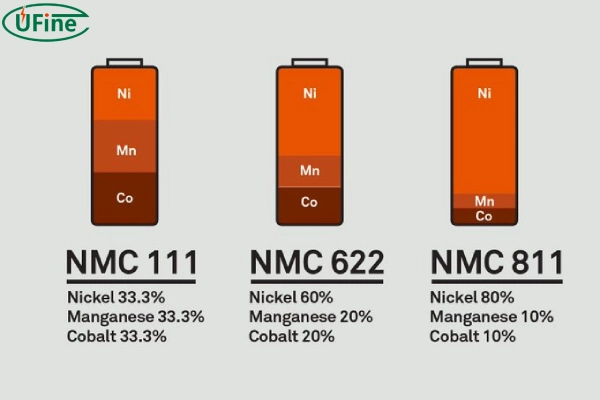
NMC lithium-ion batteries come in different types. These types may have different composition, performance, and applications. So, let’s discuss them in detail.
1. NMC 111 battery
NMC 111 has a balanced composition. This means its cathode has equal parts of nickel manganese and cobalt. Moreover, it has a good energy density cycle and is relatively inexpensive. That is why they have a wide scope of applications in various industries. These industries may include electric vehicles and consumer electronics.
2. NMC 532 battery
It is composed of more nickel than manganese and cobalt. Like NMC111, it has a relatively more energy density cycle and specific energy. Besides this, it is used in such applications where increasing energy storage capacity has a significant role. For example, in electric vehicles and grid energy storage systems.
3. NMC 622 battery
These batteries contain more cobalt. At the same time, nickel and manganese have low concentrations. It helps achieve better stability and high energy density. This battery can withstand high temperatures. O, it is commonly used in electric vehicles and stationary storage systems.
4. NMC 811 battery
This type of NMC battery features a higher nickel content. They can provide higher energy density and reduce the dependency on cobalt. NMC 811 batteries have enough energy storage capacity. So, it helps improve cost-effectiveness. Thus, it is becoming popular for electric vehicles and large-scale energy storage applications.
Part 5. Advantages and disadvantages of NMC battery
Like all other batteries, NMC lithium batteries have their pros and cons. Here are the pros and cons of NMC lithium batteries.
Pros:
- Reliable Energy Source
- High Specific Energy
- It recharges quickly.
- Long charge-discharge cycles
- It provides safety due to its thermo-stable nature.
- High energy efficiency
Cons:
- Costly as compared to other lithium batteries.
- Ethical issues concerned with cobalt mining.
- Continuous exposure to high temperatures might cause damage.
- The increasing demand for NMC lithium batteries is difficult to meet.
- Environmental concerns due to the use of environmentally unsustainable raw material
Part 6. NMC vs LFP lithium batteries
You might feel perplexed while selecting a battery for your appliances. So here is a detailed comparison between nickel, manganese, cobalt, and lithium iron phosphate batteries.
NMC lithium-ion Battery
- Specific Energy: NMC lithium has a more specific energy. So, it can comparatively store more energy in a compact mass.
- Energy Storage: NMC batteries come with less energy storage capacity than LFPs.
- Structural Framework: The structural framework of the NMC lithium-ion battery is relatively less stable. So they can easily catch fire.
- Cycle Life: NMC lithium has a short life i.e. of 800 cycles before degradation. It means that it can only undergo 800 charging and discharging cycles.
- Price: NMC lithium-ion battery has a price as compared to LFP.
- Thermal Stability: The NMC battery is less thermally stable and is at a higher risk of overheating than the LFP battery.
- Environmental Impact: Environment-unfriendly due to toxic cobalt content
- Applications: These batteries are widely used in industries like electric vehicles, smartphones, laptops, etc.
LFP Lithium Batteries
- Specific Energy: LFP lithium batteries have a lower specific energy than NMC lithium.
- Energy Storage: LFP batteries can store more energy in a large mass. They do not have a compact volume for storing large amounts of energy.
- Life Span: It has a prolonged life span of roughly ten years.
- Structural Framework: The structural framework of the LFP lithium battery is more stable and is less likely to catch fire.
- Cycle Life: LFP lithium has a high cycle life of about 3000 or more cycles.
- Price: LFP lithium battery is less expensive than NMC.
- Thermal Stability: The LFP battery is more thermally stable and is at a lower risk of overheating.
- Environmental Impact: Environment-friendly due to non-toxic raw materials.
- Applications: They are used in electric buses, grid stations, and stationary applications
This comparison will ease your battery selection process. So, let’s briefly describe it in the following table.
| Aspect | NMC Lithium Batteries | LFP Lithium Batteries |
|---|---|---|
| Cathode Material | Nickel, Manganese, Cobalt | Iron Phosphate |
| Energy Density | Higher | Lower |
| Cycle Life | Moderate to High | High |
| Safety | Moderate | High |
| Thermal Stability | Lower | Higher |
| Cost | Lower | Higher |
| Charging Speed | Faster | Slower |
| Applications | Electric vehicles, portable electronics | Solar energy storage, power tools |
Part 7. Typical prices of NMC batteries of different brands
Here are some brands and their approximate prices,
| Brands | Price Range (USD) for NMC Lithium Batteries |
|---|---|
| Panasonic | $200-$500 |
| LG Chem | $150-$400 |
| Samsung SDI | $180-$450 |
| BYD | $160-$380 |
| CATL | $170-$400 |
Part 8. FAQs
-
What is the estimated average life span of an NMC lithium-ion battery?
It ranges between 2000-2500 cycles. If properly cared for, we can increase its life to 3000-3500 cycles. After this, the battery degrades quickly. -
How much is the energy density of an NMC battery?
NMC battery is well known for its high energy density. NMC batteries usually have a specific energy of 150-200 Wh/Kg. -
What is the average voltage range of an NMC lithium-ion battery?
The average voltage range of lithium-ion NMC (nickel-manganese-cobalt)/graphite batteries is 3.5–3.7 volts.
Related Tags:
More Articles

LiPo Battery Discharge Rate Guide & Calculation Tips
Understand LiPo battery discharge rates, C-ratings, and how to calculate max current. Essential guide for RC, drones, and electronics users.
High‑Capacity 3S LiPo Batteries: 5000 mAh vs. 10000 mAh
Compare 3S LiPo 5000mAh vs 10000mAh batteries by weight, power, and use. Find the best fit for your drone, RC car, or boat setup.
Top 5 Applications for Small 3S LiPo Batteries
Small 3S LiPo batteries power drones, RC gear, wearables, and robotics with high energy and low weight. Making them ideal for compact electronics projects.
Building and Charging Your Own 3S LiPo Pack: A Step‑by‑Step Guide
Learn how to build, balance, and charge a 3S LiPo battery pack safely at home with this complete DIY guide for hobbyists and beginners.
How to Choose the Right LiPo Battery Plug Type?
Discover the best LiPo battery plug types, how to choose them, and expert tips for safe usage, soldering, and maintenance.
